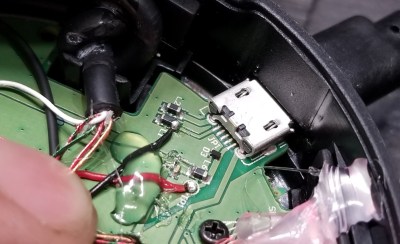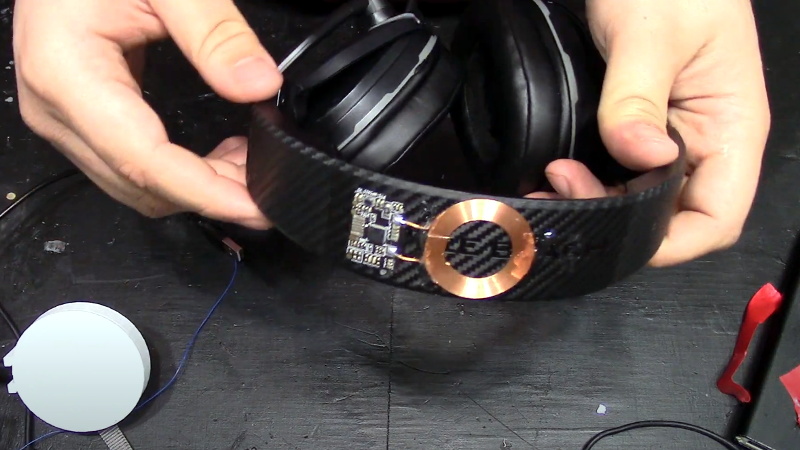Despite the technology itself being widely available and relatively cheap, devices that offer wireless charging as a feature still aren’t as common as many would like. Sure it can’t deliver as much power as something like USB-C, but for low-draw devices that don’t necessarily need to be recharged in a hurry, the convenience is undeniable.
Sick of having to plug it in after each session, [Taylor Burley] decided to take matters into his own hands and add wireless charging capability to his Turtle Beach Recon 200 headset. But ultimately, there’s nothing about this project that couldn’t be adapted to your own particular headset of choice. Or any other device that charges via USB, for that matter.
 To keep things simple, [Taylor] used an off-the-shelf wireless charging transmitter and receiver pair. The transmitter is housed in a 3D printed mount that the headset hangs from, and the receiver was simply glued to the top of the headset. The receiver is covered with a thin 3D printed plate, but a couple turns of electrical tape would work just as well if you didn’t want to design a whole new part.
To keep things simple, [Taylor] used an off-the-shelf wireless charging transmitter and receiver pair. The transmitter is housed in a 3D printed mount that the headset hangs from, and the receiver was simply glued to the top of the headset. The receiver is covered with a thin 3D printed plate, but a couple turns of electrical tape would work just as well if you didn’t want to design a whole new part.
Once everything was in place, he then ran a wire down the side of the headset and tapped into the five volt trace coming from the USB port. So now long as [Taylor] remembers to hang the headset up after he’s done playing, the battery will always be topped off the next time he reaches for it.
Considering how many projects we’ve seen that add wireless charging to consumer devices, it’s honestly kind of surprising that it’s still not a standard feature in 2021. Until manufacturers figure out what they want to do with the technology, it seems like hackers will just have to keep doing it themselves.















I did something similar, but using contacts.
http://blog.rastersoft.com/?p=1945
http://blog.rastersoft.com/?p=2139
Nice and simple, like the Sennheiser RS120 i used to use. https://en-us.sennheiser.com/audio-headphones-stereo-wireless-120-ii
It has two metal rods bent to hold your headphones and those charge 2 AAA cells in headphones.
It looks like those headphones are wired?
Some Bluetooth headsets also support wired inputs.
I’ve used cheap charger modules from ebay sources but I had to do some measurements recently to see how distance affected charge current.
Despite being rated 1A charge, 2A consumption (ie the coupling is only 50% efficient) I couldn’t get more than 250mA at 5V on the receiver side.
Is this the result of buying cheap clones or is this typical ? If there are better ones, where can I get them ?
I believe the gap plays a part. You want super thin materials covering the coil.
Probably because it’s still so inefficient to wireless charge, plugging in does it faster & less energy loss – my wireless headphones can also be used wired – still a bit of a gimmick, had a phone that had wireless charging & it was slow to charge & had to be placed precisely – I just plug in as it was easier.
Wireless charging is indeed a huge waste of power for a generally minor increase in comfort.
To a degree, I personally wouldn’t be surprised if it ends up illegal outside of a few niches.
Though, to be fair, wireless charging might already be illegal in the EU. (And this being the case from 2009, but it is more clear in the current directive, but as we can see bellow, not clear enough for me to write “are” instead of “might”.)
Since the 2019:1782 laying down ecodesign requirements for external power supplies pursuant to Directive 2009/125/EC of the European Parliament and of the Council and repealing Commission Regulation (EC) No 278/2009 (the name of the actual directive that has entered into force.)
This directive does have minimum requirements for an external (mains) power supply. A power supply under load needs to be at least 67% effective. (if bellow 49 watts. (bellow 1 watt, it is 16% on the other hand.))
If one builds a wireless charging station with an AC inlet and no other outputs. Then it is clearly illegal due to not having satisfactory efficiency. (I suggest actually reading the directive here.) Giving it some other outputs only makes it a bit more dubious, might still be illegal since one of its operation modes isn’t sufficiently efficient.
If a wireless charger that isn’t connected to the mains. (“mains” by the directive means the electricity supply from the grid of 230 ± 10 % volts of alternating current at 50 Hz. (Actually, EU mains is 230 +10 or -6 % It is on paper “harmonized” and in practice it is close enough. Ie, all EU countries shouldn’t change what they currently use. But back to wireless chargers))
Then one technically don’t have to care about this directive. BUT, one might still need to conform with it.
Since the directive looks at the efficacy from the mains, to the “primary load”.
Anything we add in-between the mains and primary load will contribute to a lower efficiency, eventually, that efficiency isn’t satisfactory. We could argue that a sufficiently long cable on the low voltage side will eat into efficiency. But we should likely look at realistic operating conditions.
But the directive never puts forth a definition of what it means by “primary load”, is it the next load in the chain? Or some other device further down our chain?
Considering how the directive puts forth a definition of what “mains” power is, and practically every other technical term we could question as well. So why didn’t it define what can be considered the primary load?
The directive is though making long lists of example loads, where non is a device mainly concerned with supplying power to something else. (If we make a technically exception to stoves and other heaters.)
There is however an exception for “battery chargers without power supply function.” But, one can place a phone on a wireless charger and still use the phone for other things than waiting for it to charge. And since the wireless charger isn’t solely powering the battery, but rather the whole device, then the charger is arguably providing some power supply functionality. However the wireless charger is typically not mains powered so not inherently subject to the directive itself.
I would argue that wireless chargers are currently legally dubious as a whole. Since we don’t know what the directive means with “primary load”, so we don’t know if the wireless charger is part of our power supply solution or not.
If the wireless charger is considered part of the power supply solution. Ie, between the mains and our primary load, then the wireless charger does eat into overall efficiency. And since there currently is no wireless chargers with efficiencies above 67%, then it can’t be used legally in practice, at least when connected to a mains connected power supply. (Non mains power sources aren’t covered by the directive after all.)
Though, realistically, the wireless charger would need to be a lot more efficient, since we also have the efficiency of the power supply, and voltage drop in realistically long cables to consider. (and yes, even the cable would matter if our primary load is on the other side of it. And here the directive could just state a simple, “cable of 100 milliohm.” and call it a day, since most normal cables have resistances around that or bellow.)
(One could though argue that the magnetic field stores energy in it, and that this technically makes the charger into an exceptionally short term UPS, and therefor except from the directive. (this here is a joke.))
I have hyper x cloud s gaming headset that is wireless charge capable and works with most wireless chargers. It’s pretty great